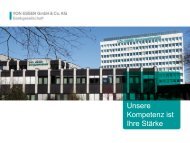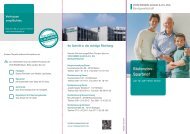2012 Registration document and annual financial report - BNP Paribas
2012 Registration document and annual financial report - BNP Paribas
2012 Registration document and annual financial report - BNP Paribas
- No tags were found...
You also want an ePaper? Increase the reach of your titles
YUMPU automatically turns print PDFs into web optimized ePapers that Google loves.
2CORPORATEGOVERNANCEReport of the Chairman of the Board of Directors on the manner of preparation <strong>and</strong> organisationof the work of the Board <strong>and</strong> on the internal control procedures implemented by the c ompany2In <strong>2012</strong>, the ICCC addressed the following issues:■ the update of the Internal Control Charter with clarification on the“second set of controls” principle, the escalation process, the duty toraise concerns, <strong>and</strong> the independence of the control functions;■ the Group’s policy on penalties for misconduct by employees;■ the Group’s policy on anti-corruption;■ the Group’s policy on h<strong>and</strong>l ing client complaints;■ the follow-up of recommendations from periodic control <strong>and</strong> regulators.PROCEDURESChecking procedures is one of the key tasks of the permanent controlsystem, alongside identifying <strong>and</strong> assessing risks, running controls,verifying <strong>report</strong>ing processes <strong>and</strong> overseeing the monitoring system.Written guidelines are distributed throughout the Group <strong>and</strong> providethe basic framework for the Group’s internal control, setting out theorganisational structures, procedures <strong>and</strong> controls to be applied. TheCompliance f unction, at headquarters level, <strong>and</strong> in the context of thesupervision of the permanent operational control system, checks thatprocedural guidelines are regularly monitored for completeness. Effortsare continuing to streamline the set of procedures <strong>and</strong> the applicablest<strong>and</strong>ards, improve their distribution <strong>and</strong> planning, make them moreaccessible <strong>and</strong> design better tools for storing them, both at the levelof cross-function al procedures <strong>and</strong> procedures for operational entities(level-3 procedures).The Group’s cross-functional guidelines (levels 1 <strong>and</strong> 2) are updated aspart of an ongoing process in which all the core businesses <strong>and</strong> functionsactively participate. As regards the organisation of controls, the twiceyearlysurveys on the effectiveness of processes have been integratedinto the twice-yearly <strong>report</strong>ing on the permanent control.Among the Group’s cross-functional procedures, applicable in all entities,the following are especially important in terms of controlling risks:■ procedures dealing with the validation of exceptional transactions,new products <strong>and</strong> new activities;■ the procedure for the approval of day-to-day credit <strong>and</strong> markettransactions.These processes essentially rely on committees (exceptional transactions,new activities <strong>and</strong> new products committees, credit committees, etc.)principally comprising operational staff <strong>and</strong> permanent control functions(Risk Management <strong>and</strong> Compliance, as well as Finance, Legal <strong>and</strong> otherfunctions involved) who exercise a “second set of controls” control oftransactions. In the event of a disagreement, it is referred to a higher levelin the organisation. At the top of the process are the Committees (CreditCommittee, Capital Market Risk Committee <strong>and</strong> Risk Policy Committee) onwhich members of Executive Management sit. In addition, since the endof 2008, a monthly Risk Committee has met, comprising all the membersof Executive Management, as well as, in particular, the Heads of GroupRisk Management (GRM) <strong>and</strong> Finance f unctions, so as to ensure morefrequent monitoring of trends in Group risks.HIGHLIGHTS OF <strong>2012</strong>Group ComplianceThe structure of the Compliance f unction remained stable in <strong>2012</strong>. Slightchanges were made to the distribution of certain responsibilities withinits central unit, Group Compliance, in order to reflect the operationalorganisation of the Group in the Divisions <strong>and</strong> Retail unit defined at theend of 2011.In <strong>2012</strong>, the following key actions were taken as a result of the Compliancef unction’s work:■ The corpus of Group st<strong>and</strong>ards was supplemented by several important<strong>document</strong>s setting out the Group’s rules <strong>and</strong> st<strong>and</strong>ards on the h<strong>and</strong>lingof client complaints, the rules relating to the proper use of electronicmessaging, organisation of relations with the French ombudsman inthe area of prevention of discrimination <strong>and</strong> the promotion of equality.■ Governance in the area of Group Financial Security <strong>and</strong> Protection ofthe i nterests of the clients was further strengthened, particularly bythe introduction of a more comprehensive set of business monitoringindicators.Among the improvements made to the corpus of Group st<strong>and</strong>ards,additions were made to the Financial Security generic control planapplicable to the Group’s entities.With the help of experts, initiatives <strong>and</strong> training on the prevention ofmoney laundering <strong>and</strong> the financing of terrorism, compliance withembargos <strong>and</strong> protection of client s’ interests continued <strong>and</strong> werestrengthened throughout the Group.■ The year <strong>2012</strong> was marked by the creation of a Group ProfessionalEthics Committee, whose main objective is to strengthen thesupervision provided by the Group Compliance f unction in the area ofp rofessional e thics. The object is to improve the effectiveness of themechanisms in the development of compliance plans <strong>and</strong> ensuringthat they are effectively monitored.■ In the area of market integrity, the market abuse preventionmechanisms have been strengthened <strong>and</strong> the new regulatoryobligations, particularly in the area of short selling, have beenimplemented.Permanent operational controlThe Group’s permanent control <strong>and</strong> operational risk managementsystem is underpinned by two key principles: strong accountability ofoperational staff for risk management <strong>and</strong> second-level control overrisk management by independent functions. Several significant steps areworthy of particular mention:■ Particular attention has been paid to the successful deploymentof the various initiatives launched in previous years with a view tobetter defining the responsibilities of first <strong>and</strong> second-level control,whether in terms of permanent control <strong>and</strong> operational risk, fraud <strong>and</strong>corruption prevention <strong>and</strong> protection, or the management of businesscontinuity.■ Awareness campaigns <strong>and</strong> training for employees on operationalrisks, <strong>and</strong> more specifically, on the risks of fraud <strong>and</strong> corruption, havebeen developed, <strong>and</strong> the offer of training <strong>and</strong> the online publicationof awareness modules have been extended.66<strong>2012</strong> <strong>Registration</strong> <strong>document</strong> <strong>and</strong> <strong>annual</strong> <strong>financial</strong> <strong>report</strong> - <strong>BNP</strong> PARIBAS





